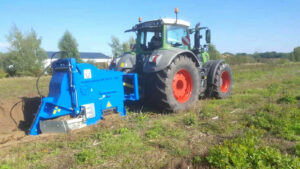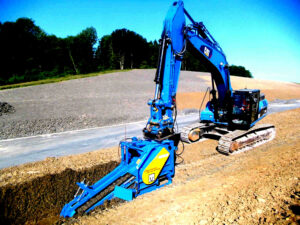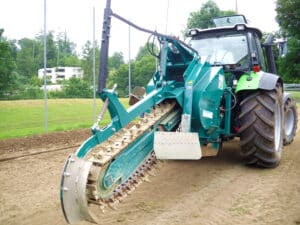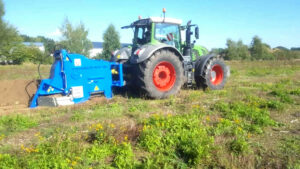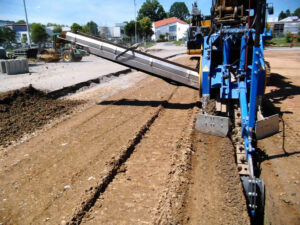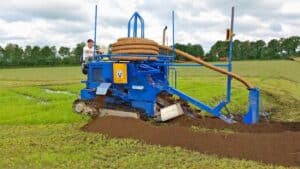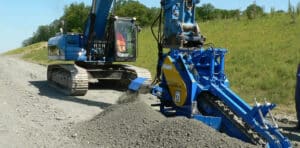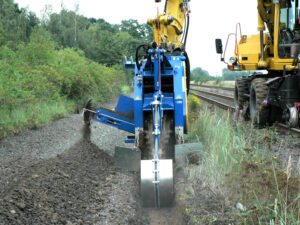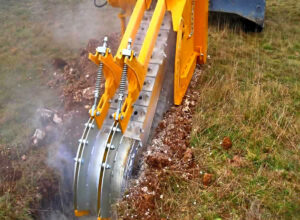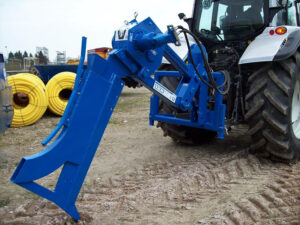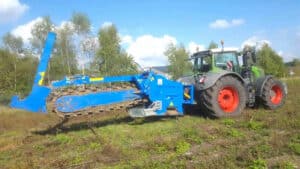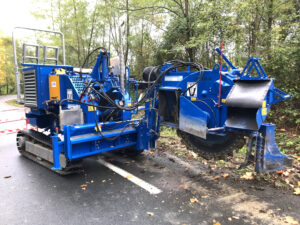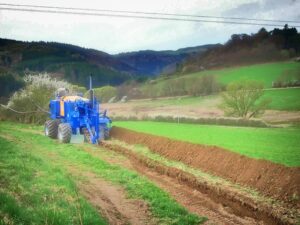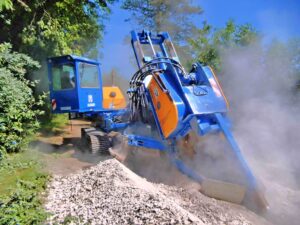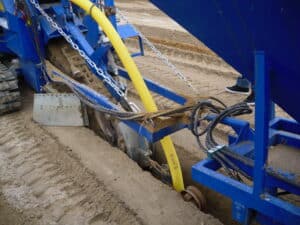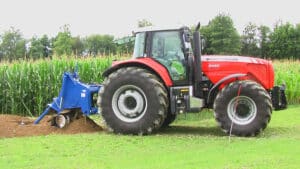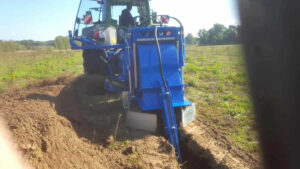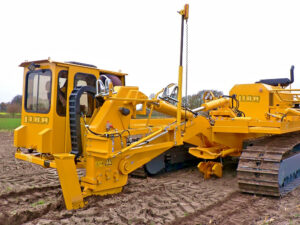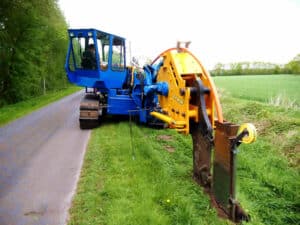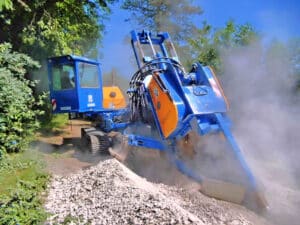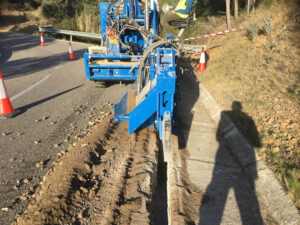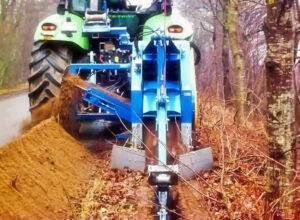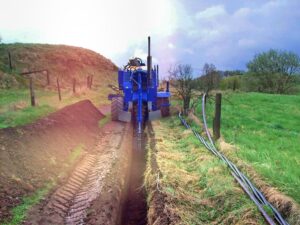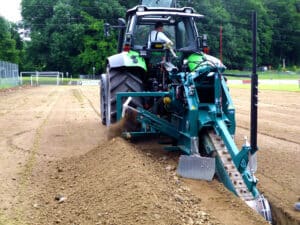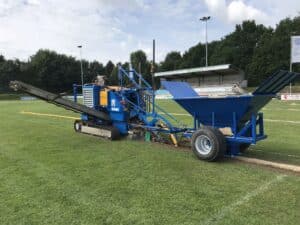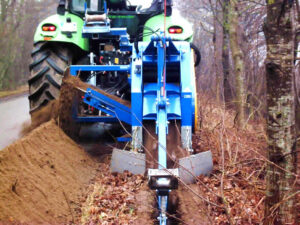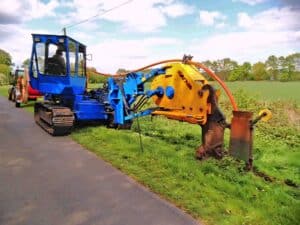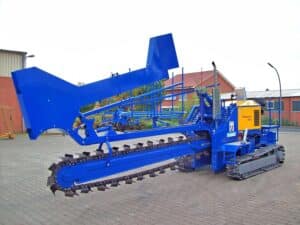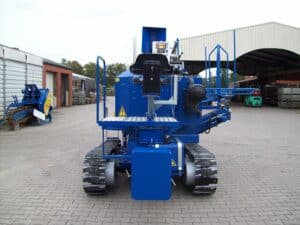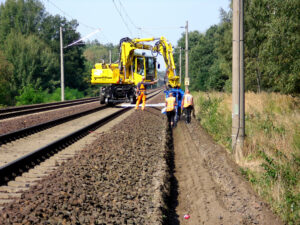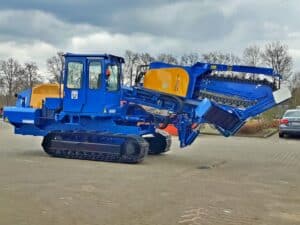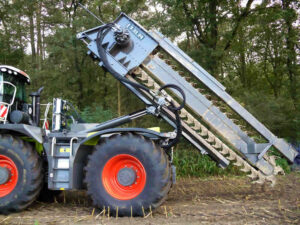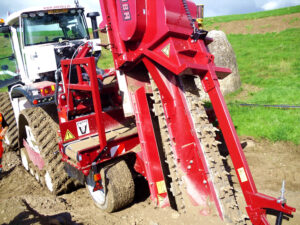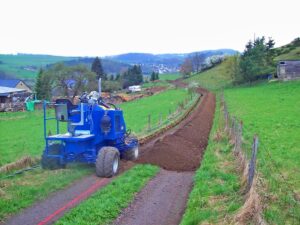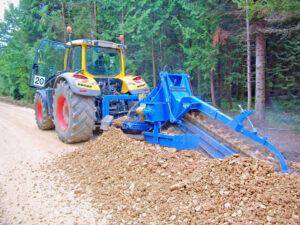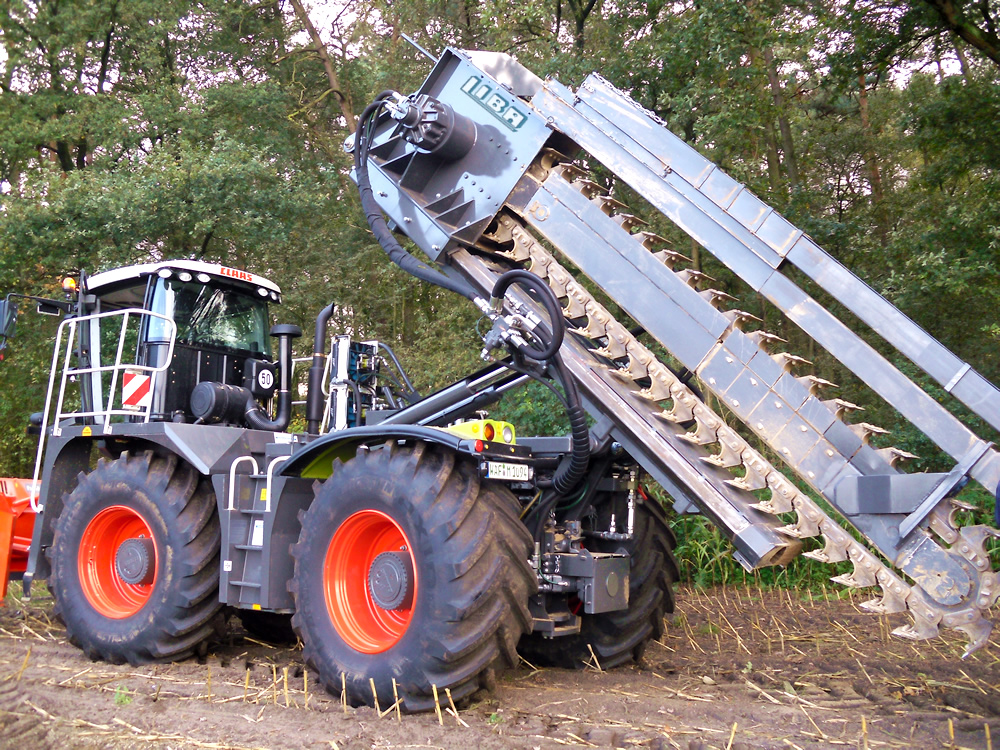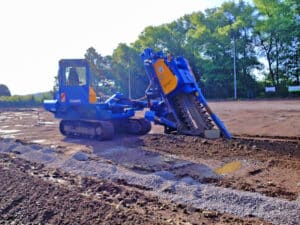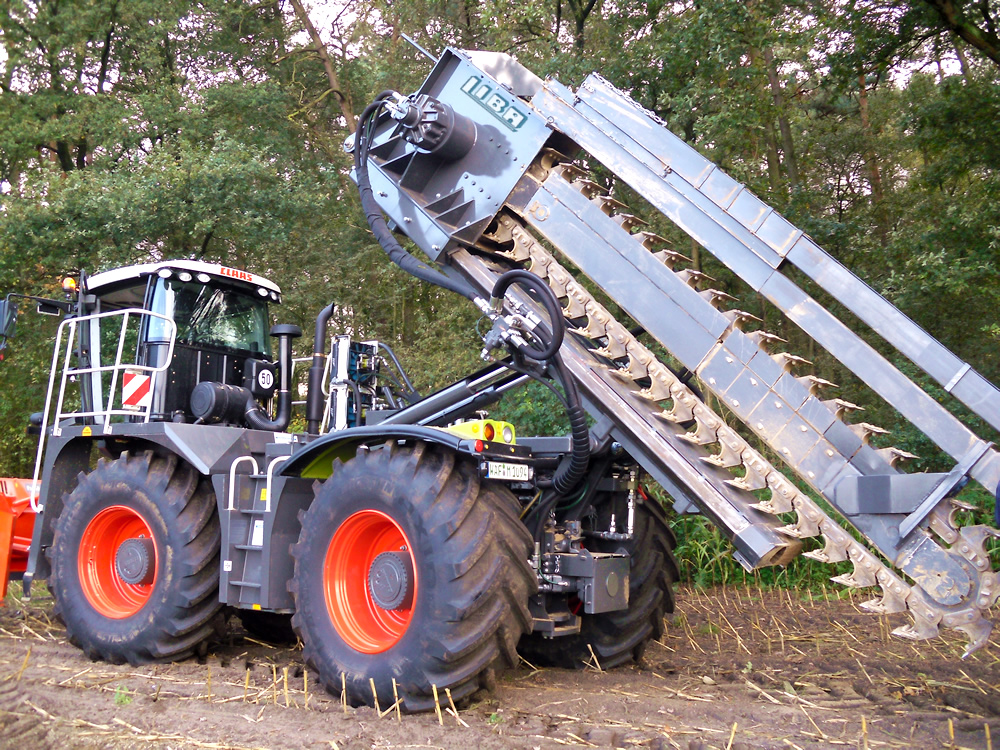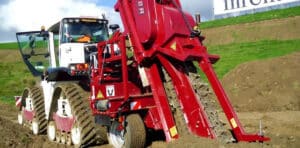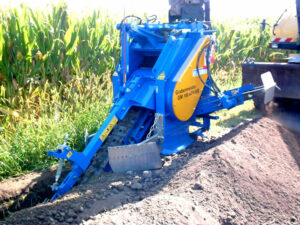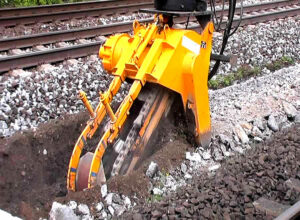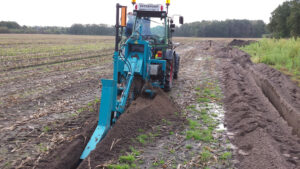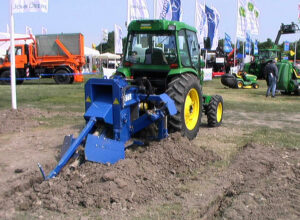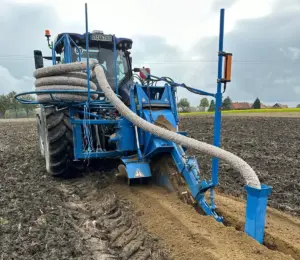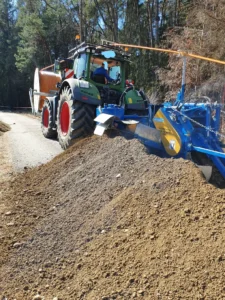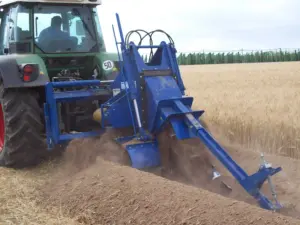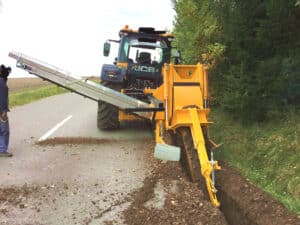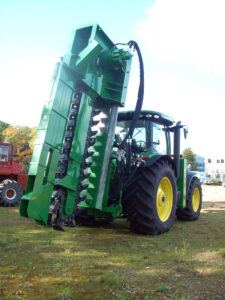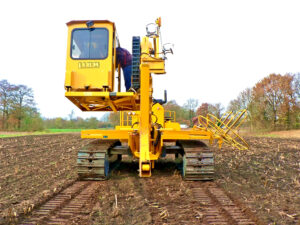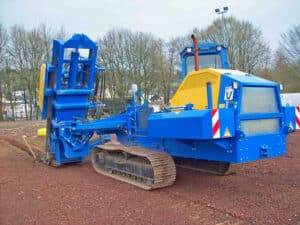Yes, self-propelled trenchers can be more environmentally friendly than some other methods of trenching. Thanks to their high efficiency and precision, they reduce the need for additional operations and thus reduce CO2 emissions. Furthermore, precise control of the tillers minimizes the possibility of over-digging and unnecessary soil removal, which reduces environmental impact.
Important information:
- Self-propelled trenchers can reduce CO2 emissions through more efficient trenching.
- Precise control prevents over digging and reduces soil removal.
There are several alternative methods for digging trenches, such as excavators or manual labor. The choice of method depends on factors such as project scope, soil characteristics, and efficiency. However, trenchers usually offer a faster and more precise solution.
Yes, the use of trenchers may be subject to certain environmental regulations. The exact regulations may vary depending on the location and type of construction project. Some common environmental requirements may include:
- Protection of Nature Preserves: Special restrictions on trenching may apply near conservation areas to protect the environment and wildlife.
- Water protection: The trench excavation must not cause pollution in the vicinity of water bodies and groundwater sources.
- Disposal of soil material: The removed soil material must be properly disposed of or recycled to minimize environmental impacts.
Important information:
- Environmental requirements may vary by location and construction project.
- Nature reserves must be protected.
- Soil material must be handled in an environmentally sound manner.
Yes, the use of cultivators in difficult terrain requires special attention:
- Stability: Ensure that the excavator or carrier machine is positioned stably on difficult ground to prevent it from tipping over during trenching.
- Soil condition: Make sure that the cultivator is suitable for the soil type to ensure efficient excavation.
- Safety measures: Take additional safety precautions to minimize accidents in challenging terrain.
Important information:
- Stable positioning of the machine in difficult terrain is important.
- The cultivator should be suitable for the type of soil.
- Additional safety precautions are required in challenging terrain.
Yes, trenchers can also be used in urban areas. There are special models designed for use in confined spaces and near buildings. Nevertheless, any noise restrictions or limitations due to local conditions must be taken into account.
Operating a trencher usually requires some training and experience. It is important to follow the manufacturer’s operating instructions and to familiarize yourself with the specific controls and safety precautions. Proper instruction on the machine is essential to ensure that it is operated efficiently and safely.
Yes, trenchers are also suitable for digging drainage ditches. They can efficiently loosen the soil and create the necessary depth and width for drainage systems. This is a common application for trenchers.
Yes, some trenchers can be equipped with various attachments and thus be used for other tasks as well. Examples of alternative uses include:
- Soil loosening: The trencher can be used for soil loosening in agricultural areas.
- Asphalt cutters: With special attachments, trenchers can also be used to remove asphalt.
- Landscaping: In landscaping, trenchers can be used in the preparation of the soil.
Important information:
- Trenchers can be used in a variety of ways with different attachments.
- Soil loosening, asphalt milling and landscaping are alternative applications.
In conclusion, the trencher is an extremely useful and versatile construction tool that is indispensable in the construction and road building industry. Through proper selection of the milling machine, environmentally conscious use, proper training of personnel and regular maintenance, construction projects can be carried out efficiently and safely. The trencher thus makes a significant contribution to shortening construction times and improving the quality of trench excavations.
Using a trencher in bad weather depends on several factors, including soil condition. In heavy rain or extremely wet conditions, it can be difficult to dig effectively. It is advisable to take weather conditions into account and make alternative work plans if necessary.
Yes, excavator-mounted trenchers can also be used for tasks other than trenching. With various attachments, they can be used in many ways, for example:
- Asphalt milling: By using a special milling drum, excavator-mounted milling machines are also suitable for removing asphalt pavements.
- Soil recycling: With a screen bucket, excavator-mounted trenchers can separate soil materials and be used for soil recycling.
- Compaction: Vibratory plate attachments enable the compaction and leveling of soil.
Important information:
- Excavator-mounted milling machines can also be used for asphalt milling, soil recycling and compaction.
- With various attachments increases their versatility.
The operation of a mounted trencher required expertise and experience in the use of construction machinery. If you have the proper training and experience, you can operate the cultivator yourself. Otherwise, it is advisable to hire a trained and experienced operator to ensure the safety and efficiency of trenching.
Important information:
- Operating a mounted tiller requires expertise and experience.
- A trained and experienced operator ensures safety and efficiency.
In conclusion, add-on trenchers offer a flexible and powerful solution for trenching in various construction projects. With regular maintenance, proper selection of the milling machine and attention to safety measures, you can optimize performance and achieve efficient results. Remember to use an experienced operator when necessary to ensure the safety and success of your construction projects.
Yes, self-propelled trenchers can be used in confined jobsite environments. Thanks to their compact design and precise control, they can work even in tight spaces and hard-to-reach areas. This makes it a practical choice for jobsites with limited space.
Important information:
- Self-propelled trenchers are compact and can be used in confined jobsite environments.
- They are particularly practical in areas with limited space.
Yes, trenchers are usually available for rent. This is a good option if the machine is only needed for certain projects or for a limited period of time. It is advisable to contact local construction equipment rental companies for information on availability and rental costs.
Attachment milling machines are particularly suitable for various construction projects and tasks:
- Road construction: mounted milling machines can be used in road development to dig trenches for pipes and drainage systems.
- Civil engineering: Attachment milling machines are extremely efficient for civil engineering work, for example for pipelines and cable laying.
- Landscaping: In landscaping, cultivators help prepare the ground for paths and planting.
Important information:
- Attachment milling machines are particularly useful in road construction, civil engineering and landscaping.
- Excavation of trenches for pipelines, drainage systems, pipelines and cable laying.
- Preparation of soil for paths and planting in landscaping.
Self-propelled trenchers are particularly suitable for a wide range of construction projects:
- Road construction: Self-propelled trenchers are ideal for digging trenches for laying cables, pipes and drainage systems in road construction.
- Sewer construction: When constructing sewers for wastewater disposal, self-propelled trenchers offer high efficiency and precision.
- Civil engineering: Self-propelled trenchers are successfully used in various civil engineering projects, such as the construction of pipelines or pipelines.
Important information:
- Road construction, sewer construction and civil engineering are suitable areas of application for self-propelled trenchers.
- Cable laying, drainage systems and pipelines can be excavated efficiently.
The excavator-mounted trencher is particularly suitable for various construction projects and tasks:
- Road construction: In road development, excavator-mounted trenchers can precisely dig trenches for pipes and drainage systems.
- Cable laying: The excavator-mounted trencher is ideal for laying cables and lines.
- Sewer construction: When constructing sewers, the excavator-mounted trencher enables efficient trenching.
Important information:
- Excavator-mounted milling machines are particularly effective in road construction, cable laying and sewer construction work.
- Precise trenching for lines, cables and sewers.
To optimize the performance of your mounted tiller, you can take the following measures:
- Regular maintenance: Ensure that your attachment trencher is serviced regularly to ensure smooth operation and avoid unnecessary downtime.
- Choose the right attachment: Select the right attachment for your specific needs to increase trenching efficiency and precision.
- Use of wear parts: Be sure to replace worn wear parts in a timely manner to ensure optimum performance of the cultivator.
Important information:
- Regular maintenance is critical for smooth operation.
- The right attachment increases the efficiency and precision of trenching.
- Replacing wear parts keeps the attachment tiller at optimum performance.
Choosing the right trencher depends on several factors. Important aspects are:
- Size requirements: Milling width and depth must meet project requirements.
- Soil condition: The type of soil in which the trench is to be excavated influences the selection of the right trencher.
- Working environment: The size and accessibility of the construction site as well as possible obstacles must be taken into account.
Important information:
- The milling width and depth must meet the project requirements.
- The condition of the soil influences the selection of the tiller.
- Consider the work environment, including job site size and accessibility.
Self-propelled trenchers have an integrated engine and drive systems that move the trencher independently of external vehicles. The milling drum rotates and excavates the soil while the machine moves forward independently. This type of trencher provides high efficiency and enables precise control during trenching.
Important information:
- Self-propelled trenchers have their own engine and drive system.
- The milling drum is driven by the integrated drive.
- High efficiency and precise control are characteristic of self-propelled trenchers.
An attachment trencher is mounted on the excavator arm or the construction machine and is driven by the hydraulics of the carrier vehicle. The milling drum rotates and excavates the soil while the excavator or carrier vehicle controls the advance. The cultivator works by loosening and removing the soil, allowing for precise and efficient trenching.
Important information:
- Attachment cutters are attached to excavator arms or other construction equipment.
- The milling drum is driven by the hydraulics of the carrier vehicle.
- Precise and efficient trenching is achieved by loosening and removing the soil.
An excavator-mounted trencher is mounted on the excavator arm and powered by the excavator’s hydraulics. The milling drum rotates and excavates the soil while the excavator controls the advance. The excavator-mounted trencher efficiently loosens and removes soil to dig precise and clean trenches.
Important information:
- The excavator attachment is mounted on the excavator arm.
- The milling drum is driven by the excavator’s hydraulics.
- Efficient digging of precise and clean trenches by loosening and removing the soil.
To extend the life of a trencher, regular maintenance and care is critical. This includes timely replacement of wear parts, cleaning the machine after use, checking and refilling lubricants, and proper storage when the machine is not in use.
Regular maintenance of an excavator-mounted trencher is important to maintain its performance and minimize downtime. Important maintenance procedures are:
- Daily inspection: Before each use, the excavator-mounted trencher should be checked for damage, wear and loose parts.
- Lubrication: The moving parts must be lubricated regularly to ensure smooth operation.
- Hydraulic fluid: The hydraulic oil level should be checked regularly and topped up if necessary.
Important information:
- Daily inspection before each use is critical.
- Regular lubrication of the moving parts ensures smooth operation.
- Checking and, if necessary, topping up the hydraulic fluid are part of the maintenance.
The excavator-mounted trencher offers several advantages over other trenchers:
- High flexibility: excavator-mounted milling machines can be adapted to different excavator sizes and can therefore be used in various construction projects.
- Efficiency: The hydraulic system of the excavator enables powerful and efficient trenching.
- Precise control: The excavator operator has full control over the movements of the backhoe attachment, which enables precise control.
Important information:
- Excavator attachments adapt to different sizes of excavators.
- Efficient trenching through the power of hydraulics.
- Precise control by the excavator operator.
Excavator-mounted trenchers also offer advantages for backfilling trenches after excavation:
- Efficiency: The same backhoe attachment can not only dig trenches, but also efficiently backfill the excavated soil, saving time and labor.
- Soil compaction: With the help of attachments such as vibratory plates, excavator-mounted trenchers can simultaneously compact the backfilled soil to create a solid foundation.
- Clean finish: Precise control allows the trench to be backfilled cleanly and evenly, resulting in an aesthetically pleasing and functional finish.
Important information:
- Excavator-mounted trenchers save time and labor during trench backfilling.
- Soil compaction by attachments ensures a solid foundation.
- Precise control ensures a clean and aesthetically pleasing finish.
Attachment trenchers offer several advantages over stand-alone trenchers:
- High flexibility: Attachable milling machines can be mounted on different excavator sizes and construction machines, which extends the range of applications.
- Cost-efficiency: Since the add-on trencher works in conjunction with an existing carrier vehicle, separate acquisition costs for a stand-alone trencher are not required.
- Space saving: Mounting on a carrier vehicle optimizes site set-up, especially in confined areas.
Important information:
- Attachment cutters adapt to different excavator sizes and construction machines.
- Cost savings by using an existing carrier vehicle.
- Space saving for site installation, especially in confined areas.
Self-propelled trenchers offer some outstanding advantages over other trenchers:
- Independence: Because they have their own drive, self-propelled trenchers are independent of external carrier vehicles and can maneuver flexibly on the job site.
- High mobility: The self-propelled features make it easy to move between different job sites without incurring additional transportation costs.
- Time saving: The high speed and efficiency of these milling machines lead to significant time saving in trenching operations.
Important information:
- Independence from external carrier vehicles enables high flexibility.
- Self-propelled trenchers can easily move between job sites.
- The high speed and efficiency advantage leads to time savings in trenching operations.
Using a trencher offers several advantages over traditional trenching methods. The main advantages include: – Efficiency: Trenchers can dig trenches quickly and accurately, which significantly reduces construction time. – Precision: Precise control of the milling depth and width allows accurately sized trenches to be created. – Reduced soil compaction: The milling motion minimizes soil compaction, which provides better base stability.
Important information:
- Fast trenching results in shortened construction times.
- Precise control allows accurate dimensions of the trenches.
- Lower soil compaction increases basic stability.
The cost of using a mounted tiller depends on various factors:
- Rental or purchase cost: Companies can choose to buy or rent a cultivator, depending on the project duration and budget.
- Operating costs: This includes fuel consumption, wear parts and, if applicable, the cost of disposing of spoil material.
- Maintenance and repair costs: Regular maintenance and occasional repairs must be included in the operating costs.
Important information:
- Rental or purchase costs depend on project duration and budget.
- Operating costs include fuel, wear parts and waste disposal.
- Maintenance and repairs are part of the operating costs.
When buying a trencher should pay attention to some important quality features, such as the power and reliability of the engine, the durability of the cutting tools and components, the ease of use of the machine and the reputation of the manufacturer. Thorough research and comparison of different models are advisable to make the best choice.
Operating costs for self-propelled trenchers can vary compared to other methods of trenching. However, operating costs are typically competitive, as self-propelled trenchers offer high efficiency and reduce the need for additional machinery and labor. It is important to consider the specific cost factors for each construction project.
Important information:
- Operating costs of self-propelled trenchers can be competitive.
- High efficiency and reduced need for additional machinery and labor contribute to cost effectiveness.
In conclusion, self-propelled trenchers provide a powerful solution for trenching in various construction projects. Their independence, mobility and efficiency make them an attractive option for contractors looking to perform precise and time-saving trenching operations. When deciding on a self-propelled trencher, project requirements, environmental impact and overall cost should be carefully weighed.
What are the operating costs of an excavator-mounted trencher compared to other trenching methods?
The operating costs of an excavator-mounted trencher can vary compared to other trenching methods. However, operating costs are usually competitive, as backhoe-mounted milling machines offer high efficiency and performance. With the ability to attach them to different sizes of excavators, they can also reduce the need for additional machinery, saving money.
Important information:
- The operating costs of excavator-mounted trencher are usually competitive.
- High efficiency and the ability to attach them to different excavators can save costs.
The maintenance intervals for an excavator-mounted trencher can vary depending on the manufacturer and use. Generally recommended maintenance intervals are:
- Daily inspection: Before each use, the excavator-mounted trencher should be checked for damage, wear and loose parts.
- Regular Maintenance: Thorough maintenance should be performed according to the manufacturer’s instructions to ensure optimum performance and safety.
Important information:
- Daily inspection before each use is recommended.
- Regular maintenance according to manufacturer’s instructions ensures optimum performance.
In the construction and road building industry, there are different types of trenchers that can be used depending on the requirements of the project. The most common types include: – Excavator Attachment Cutters: Attach to excavator arms and are versatile. – Wheel cutters: Suitable for use on hard surfaces and in confined areas. – Chain trencher: Suitable for trenching in difficult terrain and uneven ground.
Important information:
- Excavator-mounted milling machines are versatile and are attached to excavator arms.
- Wheel cutters are suitable for hard surfaces and narrow areas.
- Chain tillers are ideal for difficult terrain and uneven surfaces.
Various attachments can be fitted to self-propelled trenchers to extend their range of applications:
- Cutting discs: For cutting and removing asphalt on road construction sites.
- Sieve bucket: For separation of excavation materials and for soil recycling.
- Vibratory plates: For compacting and leveling the excavated soil.
Important information:
- Cut-off wheels allow you to cut and remove asphalt.
- Screening buckets are used for material separation and soil recycling.
- Vibratory plates are used to compact and level the excavated soil.
When choosing a mounted tiller, there are several factors to consider:
- Excavator size: The attachment should match the excavator size to ensure optimum performance.
- Milling width and depth: The dimensions of the milling machine must meet the project requirements.
- Soil conditions: Special tillers may need to be selected depending on the type of soil.
Important information:
- Attachment trencher should fit the excavator size.
- Milling width and depth must meet project requirements.
- Make selection according to the soil conditions.
When choosing an excavator-mounted trencher, there are some important factors to consider:
- Excavator size: The cutter should match the excavator size to ensure optimum performance and efficiency.
- Milling width and depth: The dimensions of the milling machine must meet the specific requirements of the construction project.
- Attachment system: It is important to ensure that the attachment system of the backhoe attachment is compatible with the excavator.
Important information:
- The excavator attachment trencher should fit the size of the excavator.
- Milling width and depth must meet project requirements.
- The compatibility of the cultivation system is an important aspect in the selection.
When selecting a self-propelled trencher, consider the following factors:
- Engine power: The engine power should meet the requirements of the construction project to ensure efficient trenching.
- Milling width and depth: The dimensions of the milling machine must meet the specific project requirements.
- Off-road capability: The ability to handle difficult terrain is critical, especially on challenging construction projects.
Important information:
- The engine power should meet the requirements of the construction project.
- The milling width and depth must meet the project requirements.
- Off-road capability plays an important role for demanding construction projects.
Trencher is a specialized construction equipment used for excavation of trenches in various construction projects. It consists of a rotating milling drum that loosens and excavates the soil. Trenchers are used in the construction and road building industry to dig trenches for cable laying, pipelines, drainage systems and other purposes.
Important information:
- Trenchers are construction equipment that digs trenches for various purposes.
- They have a rotating milling drum to loosen and remove soil.
- Areas of application are cable laying, pipelines and drainage systems.
The fuel consumption of a trencher varies depending on the model and operating conditions. Larger machines with higher power will usually consume more fuel than smaller models. It is important to check the specific manufacturer’s specifications and consider fuel consumption when calculating operating costs.
Regular trencher maintenance is critical to ensure optimal performance and safety. Important maintenance procedures are:
- Daily inspection: Before each use, the milling machine should be checked for damage and wear.
- Lubrication: The moving parts of the milling machine must be lubricated according to the manufacturer’s instructions.
- Filter change: Air and oil filters must be changed regularly to maintain good engine performance.
Important information:
- Daily inspection before each use is important.
- Lubrication of the moving parts is part of the maintenance.
- Filters for air and oil must be changed regularly.
In conclusion, the trencher is a powerful tool in the construction and road building industry that enables efficient digging of trenches. Proper selection of the milling machine, adherence to safety precautions, and regular maintenance are critical to achieving the best results and ensuring the safety of personnel. Using this specialized construction equipment allows construction projects to be completed faster and more accurately, resulting in increased productivity and cost efficiency.
Operator training is critical to operating the trencher safely and efficiently. Important aspects of the training are:
- Technical Understanding: Operators must understand how the trencher works and how to properly control it.
- Safety training: Personnel must be informed about the necessary safety precautions and how to deal with emergency situations.
- Field Experience: Reasonable experience working with construction equipment and in the field is a plus.
Important information:
- Technical understanding of the trencher is important.
- Safety training for the operating personnel is mandatory.
- Experience in the field facilitates the operation of the machine.
Certain safety precautions must be observed when transporting a mounted tiller:
- Attachment: The attachment trencher must be securely and firmly fastened to the excavator or carrier machine to prevent slipping during transport.
- Visibility: Warning signs and reflectors must be in place to alert other road users to the oversized cargo.
- Speed: The transport speed should comply with the applicable regulations and be adapted to the load.
Important information:
- Secure attachment of the attachment tiller during transport is crucial.
- Warning labels and reflectors increase visibility during transport.
- The transport speed should comply with the applicable regulations and be adapted to the load.
In conclusion, mounted milling machines offer high flexibility and versatility in the construction and road building industry. Through proper selection, proper maintenance, and strict adherence to safety precautions, mounted trenchers can be operated efficiently and safely to accurately excavate trenches and successfully complete construction projects. Consideration of costs and compliance with transportation regulations help make the use of this useful construction equipment even more effective.
Operating an excavator-mounted trencher requires adherence to strict safety precautions:
- Operator training: Personnel must receive thorough training in the safe operation of the backhoe attachment.
- Personal protective equipment: Wearing a safety helmet, safety goggles, gloves and sturdy shoes is mandatory.
- Working environment: The construction site must be properly secured and other workers should be at a safe distance from the backhoe attachment.
Important information:
- Operators must be safely trained in the use of the backhoe attachment.
- Personal protective equipment is mandatory during operation.
- The construction site must be adequately secured and safety distances should be maintained.
Safe operation of a self-propelled trencher requires strict adherence to safety precautions:
- Operator training: Personnel must receive thorough training in the operation and control of the machine.
- Safety distances: Persons should stay at an appropriate distance from the milling drum during operation to avoid accidents.
- Personal protective equipment: Wearing a safety helmet, safety glasses, gloves and sturdy shoes is essential.
Important information:
- Operators must be safely trained in the use of the self-propelled trencher.
- Safety distances to persons must be maintained to avoid accidents.
- Personal protective equipment is mandatory during operation.
In conclusion, self-propelled trenchers offer high flexibility and efficiency in trenching in various construction projects. Through proper selection, adherence to safety precautions and regular maintenance, they can contribute to successful and time-optimized construction projects. Consideration of project requirements and ensuring proper operation ensure smooth operation.
Special care should be taken when digging near utility lines. Before using a trencher, information should be obtained about the location of the lines, and it is important that trained professionals perform this work to minimize the risk of damage.
Operating a trencher requires strict adherence to safety precautions to prevent accidents. Important safety measures include:
- Operator training: The machine operator must receive thorough training in the operation of the trencher.
- Personal protective equipment: Wearing a safety helmet, safety goggles, gloves and sturdy shoes is mandatory.
- Safety distances: Persons should stay at an appropriate distance from the milling drum during operation.
Important information:
- The operating personnel must receive appropriate training.
- Personal protective equipment is required during operation.
- Safety distances to persons must be maintained.
Self-propelled trenchers offer their advantages in various fields of application:
- Urban development: In urban areas where space is often limited, self-propelled trenchers enable precise digging of trenches for infrastructure projects such as utility lines and fiber optic cables.
- Pipeline construction: When laying pipelines over long distances, self-propelled trenchers can increase efficiency and reduce costs.
- Structural and civil engineering: Self-propelled trenchers facilitate trenching work on structural engineering projects such as foundations or civil engineering projects such as sewers.
Important information:
- Urban areas, pipeline construction and civil engineering benefit from self-propelled trenchers.
- Precise trenching for utilities, pipelines and foundations is made possible.


